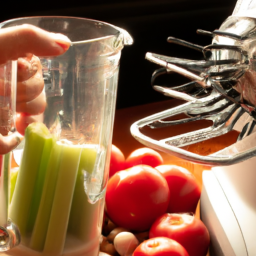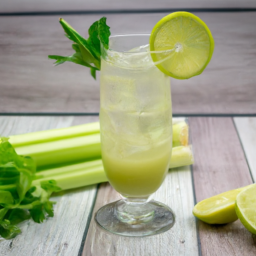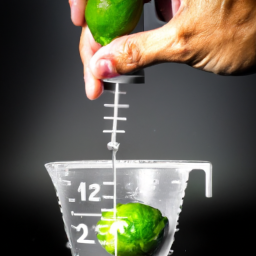I have always loved cooking and preparing food, and I’ve learned that having a good quality cutting board is essential in any kitchen. It is important to have a sturdy and reliable board for cutting, slicing, and mincing ingredients to protect your countertops and knives.
But a cutting board with a juice groove takes things to the next level. A juice groove is a shallow indentation around the perimeter of a cutting board that collects excess liquids and prevents them from spilling onto your counter. It’s particularly useful when working with juicy fruits, vegetables, or meats that release liquids while being cut.
In this article, I’ll guide you through the process of making a juice groove in your cutting board, so you can elevate your cooking game and keep your kitchen clean.
Key Takeaways
- Choosing the right wood is crucial for making a juice groove, as soft woods like pine or cedar should be avoided for cutting boards.
- Using a router is the most efficient and effective method for creating a juice groove, but precision is key.
- Maintaining the juice groove is important for preventing cross-contamination, reducing mess, and extending the life of the cutting board.
- Applying a food-safe finish to the cutting board can protect the wood from moisture and bacteria, but it is important to thoroughly clean and dry the board before application and to regularly oil it to prevent drying out and cracking over time.
Gather Your Materials
Gotta grab all the tools and supplies you need to create a perfect juice groove on your cutting board!
First things first, choosing the right wood is crucial. You want a wood that is dense and hard, such as maple, cherry, or walnut. Avoid softer woods like pine or cedar, as they are more prone to scratches and dents.
Once you have the right wood, it’s time to gather the necessary tools and equipment. You’ll need a router with a straight bit, a measuring tape, a pencil, a clamp, and safety equipment such as safety glasses and ear protection.
When working with power tools, safety should always come first. Make sure you have the appropriate safety equipment before beginning the project. Safety glasses will protect your eyes from flying wood chips, while ear protection will prevent hearing damage from the noise of the router.
Once you have all the necessary tools and safety equipment, you’re ready to move on to the next step: measuring and marking your cutting board.
Measure and Mark Your Cutting Board
You’ll need to measure and mark the surface of your wooden block before creating a functional indentation. Precision is key when making a juice groove, as it needs to be deep enough to collect any juices from your meat or vegetables, but not so deep that it compromises the integrity of the board. This is where the importance of precision comes in.
To achieve the perfect depth, you’ll need to choose the right marking tool. A pencil is a good option, but it can be difficult to see on darker woods. Alternatively, a chalk line or a white colored pencil can provide greater visibility. Once you have your marking tool, use a ruler or a straight edge to make your marks. Be sure to double-check your measurements before making any cuts. With these steps, you can be sure that you’ll end up with a functional and aesthetically pleasing juice groove. Now, to secure your cutting board…
Secure Your Cutting Board
To keep your wooden block in place while you prepare your ingredients, simply grab a damp towel and fold it into a thick pad, then place it underneath the corners of the board. This will prevent the board from sliding around while you work, ensuring a safe and stable cutting surface.
However, if you have a larger cutting board or prefer a more permanent solution, you may want to consider using silicone mats. These mats provide a non-slip surface that grips the counter, making it easier to chop and slice with precision.
When choosing a cutting board size, it’s important to consider the amount of space you have in your kitchen and the types of ingredients you typically work with. A larger board may be more versatile and allow you to work with a wider range of foods, but it may also be more cumbersome to handle and store. On the other hand, a smaller board may be easier to maneuver but may not provide enough room for larger items like roasts or whole chickens.
Once you have your board securely in place, you can move on to the next step: using a router to cut the groove.
Use the Router to Cut the Groove
I’ll now discuss using the router to cut the juice groove in your cutting board.
Before you begin, make sure to select the appropriate router bit for the job. Once you have the right bit, adjust the depth of the bit to match the desired depth of the groove.
Then, carefully cut the groove along your marked line. Take care to follow your template and remove any excess wood.
Select the Appropriate Router Bit
When selecting the appropriate router bit, have you considered the type of wood you’re using for your cutting board? The type of wood will determine the best router bit to use for your juice groove.
Here are a few options to choose from:
-
Straight bit – This bit is a good option for softer woods like pine or cedar. It will create a clean and smooth groove, but it may not be the best choice for harder woods.
-
Spiral up-cut bit – This bit is a great option for harder woods like maple or cherry. It will create a deep and clean groove, but it may also cause tear-out if not used correctly.
-
Bottom cleaning bit – This bit is ideal for finishing the groove and cleaning up any rough edges left by the other bits. It’s a good option to use after using either a straight or spiral up-cut bit.
Router bit selection is an important aspect of cutting board maintenance. Using the wrong bit can damage the wood and ruin the groove.
Once you’ve selected the appropriate bit, it’s time to adjust the depth of the bit to create the perfect groove for your cutting board.
Adjust the Depth of the Bit
Once you’ve determined the best router bit for your wood type, it’s important to adjust the depth of the bit to ensure a precise and clean cut for your desired design. Bit selection is crucial in achieving your desired design, but routing technique is just as important. Adjusting the depth of your router bit is an essential step in the routing process, as it helps to prevent any mistakes that may occur during the cutting process.
To adjust the depth of the bit, you will need to use your router’s depth adjustment system. This system typically consists of a depth gauge and a locking mechanism. Use the gauge to determine the desired depth of the bit, and then lock it in place. It’s important to note that the depth of the bit should be slightly less than the thickness of your cutting board. A depth gauge can help you achieve the desired depth, and the locking mechanism will prevent the bit from moving during the routing process. Once you’ve adjusted the depth of your router bit, you can move on to the next step, which is to cut the groove along your marked line.
Table:
| Action | Procedure |
|---|---|
| 1. | Use your router’s depth adjustment system |
| 2. | Determine the desired depth of the bit |
| 3. | Lock the bit in place |
| 4. | Ensure that the depth of the bit is slightly less than the thickness of your cutting board |
Cut the Groove Along Your Marked Line
To achieve a precise and clean design, it’s important to adjust the depth of your router bit and then smoothly route along your marked line. Make sure that the router bit is securely tightened and that the depth is adjusted to the desired measurement.
Begin routing the groove at one end of the board and work your way towards the other end, being mindful to keep the router flat and level. Take your time and make sure to maintain a steady pace so that you don’t accidentally veer off course.
Alternative methods for creating a juice groove include using a chisel or a hand saw, but these methods can be more time-consuming and less precise. While a hand saw may be useful for creating a straight line, it can be difficult to maintain a consistent depth. Additionally, using a chisel requires a certain level of skill and precision to achieve a clean and accurate cut.
Overall, using a router is the most efficient and effective method for creating a juice groove in a cutting board.
Now that the groove has been routed, it’s time to clean up any rough edges or imperfections.
Clean Up the Groove
Don’t forget to regularly clean out the juice groove with a mixture of vinegar and water to ensure your cutting board stays hygienic and safe for your family’s meals. Cleaning methods are essential to prevent bacteria from accumulating in the groove.
First, make sure to wipe the groove clean after each use with a damp cloth. For tougher stains, use a mixture of 1 part vinegar to 3 parts water and scrub the groove with a brush. Rinse the groove with water and dry it thoroughly with a clean towel.
Additionally, it’s important to sanitize the groove periodically. You can do this by pouring a small amount of hydrogen peroxide into the groove and letting it sit for a few minutes before rinsing it with water. Remember to dry the groove thoroughly afterward.
By taking these steps, you can ensure that your cutting board remains safe for food preparation. With a clean and sanitized juice groove, you can move on to the next step of testing your groove.
Test Your Groove
Now that I’ve created a juice groove in my cutting board, it’s time to test it.
To do so, I run water over the groove and check for proper drainage.
This step is crucial to ensure that the groove effectively catches any liquids and prevents them from spilling onto my countertop.
Run Water Over the Groove
Simply run water over the groove and watch as the debris washes away, leaving a clean and functional cutting board. Proper maintenance of your cutting board’s juice groove has numerous benefits, including preventing cross-contamination, reducing mess, and extending the life of your cutting board.
Here are four steps to follow when running water over the groove:
- Use a gentle flow of water to rinse the groove. Avoid using high-pressure water, which can cause damage to the board.
- Use a soft-bristled brush to gently scrub the groove. Be sure to remove any remaining food particles or debris.
- Dry the cutting board with a clean towel to prevent water damage and mold growth.
- Apply a food-safe mineral oil to the board once it’s dry. This helps keep the wood from drying out and cracking.
After completing the process of running water over the groove, it’s important to check for proper drainage. A clogged groove can cause water to pool, which can lead to bacterial growth and other issues.
To ensure proper drainage, tilt your cutting board and watch as the water runs out of the groove. If water doesn’t drain properly, use a small tool to remove any obstructions.
Check for Proper Drainage
Ensure that your cutting surface is free of obstructions to allow for proper drainage of water from the carved channel. This is crucial for maintaining the hygiene of your cutting board.
The juice groove is designed to collect juices and prevent them from spilling onto your countertop, but it can also be a breeding ground for bacteria if not cleaned properly. To avoid this, make sure that water can flow freely through the groove and away from the board.
The type of cutting board material you use can also affect the drainage of your juice groove. Hardwood, such as maple or walnut, is a popular choice for cutting boards because of its durability and resistance to knife marks. However, it can be more difficult to carve a deep groove into this type of wood, which can impede proper drainage.
On the other hand, plastic cutting boards are easier to carve and maintain, but they can also develop deep scratches that harbor bacteria. Regardless of the material, it’s important to regularly clean and disinfect your cutting board to ensure its longevity and safety.
Now that the groove is properly drained, let’s move on to applying a finish to your cutting board.
Apply a Finish
Now that I’ve successfully created a juice groove in my cutting board, it’s time to apply a food-safe finish. This will not only protect the wood from moisture and bacteria, but it will also enhance the beauty of the board.
I’ll make sure to allow the finish to dry completely before using the cutting board.
Apply a Food-Safe Finish
After all your hard work carving out the juice groove, it’s important to protect your cutting board with a food-safe finish like mineral oil or beeswax. This acts like a shield for your board just like a coat of armor protects a knight in battle.
Applying a food-safe finish provides numerous benefits, such as preventing the growth of bacteria and extending the life of your cutting board. However, it’s important to note that there are also some drawbacks to using certain finishing options, such as the need for frequent reapplication and the potential for a sticky or greasy residue.
To apply a food-safe finish, start by thoroughly cleaning your cutting board and allowing it to dry completely. Next, apply a thin layer of mineral oil or beeswax to the entire surface of the board, making sure to cover the juice groove as well. Use a clean cloth or paper towel to work the finish into the wood, and allow it to soak in for several hours or overnight.
Finally, wipe off any excess finish and allow it to dry completely before using your cutting board again. Now that you’ve applied your food-safe finish, it’s important to allow it to dry completely before using your cutting board again. This will usually take several hours or overnight, depending on the type of finish you used and the climate in your area.
Once the finish is completely dry, you can start using your cutting board again with the peace of mind that it is protected and ready for all your culinary adventures.
Allow Finish to Dry
Once you’ve applied a food-safe finish to your wooden cutting board, it’s important to allow it to dry completely before using it again. The benefits of drying your cutting board after applying a finish are numerous. Firstly, it ensures that the finish has properly cured and will provide the maximum protection possible. Secondly, it prevents any potential health hazards that could arise from using a wet or tacky cutting board. Finally, it helps to prolong the lifespan of your cutting board by preventing any moisture from seeping into the wood and causing it to warp or crack.
It’s important to exercise patience when allowing your cutting board to dry after applying a finish. The amount of time it takes for the finish to dry will depend on the type of finish used and the humidity level in your kitchen. In general, it’s best to wait at least 24 hours before using your cutting board again. During this time, make sure that the board is placed in a dry, well-ventilated area away from direct sunlight. Once the finish is completely dry, you can move on to the next step in maintaining your cutting board.
Maintain Your Cutting Board
To properly maintain your cutting board, it’s important to regularly oil it and avoid submerging it in water for extended periods of time. Oiling your cutting board will help to prevent it from drying out and cracking over time.
There are a variety of oils that can be used, including mineral oil, beeswax, and coconut oil. To oil your cutting board, simply apply a thin layer of oil to the surface of the board using a clean cloth or paper towel. Allow the oil to soak into the wood for several hours or overnight before wiping off any excess oil with a clean cloth.
In addition to oiling your cutting board, it’s important to clean it regularly to prevent the buildup of bacteria and other contaminants. To clean your cutting board, simply wash it with hot, soapy water, using a scrub brush or sponge to remove any debris. Rinse the board thoroughly with hot water and dry it with a clean towel.
Avoid using harsh chemical cleaners or abrasive sponges, as these can damage the surface of the board. By regularly oiling and cleaning your cutting board, you can help to prolong its lifespan and ensure that it remains in good condition for years to come.
And speaking of good condition, have you ever considered the benefits of a juice groove on your cutting board?
Benefits of a Juice Groove
You may not realize it, but adding a juice groove to your trusty kitchen tool can reduce the risk of cross-contamination by up to 99%. Here are some of the hygienic benefits that come with incorporating a juice groove into your cutting board:
- It prevents liquids from spilling over the edge and onto your countertops or floors, which can harbor bacteria.
- It traps juices from raw meat, poultry, and fish, preventing them from spreading to other foods and reducing the risk of foodborne illness.
- It makes cleaning easier by containing any mess within the groove, allowing you to focus on thoroughly sanitizing the surface.
- It adds an extra layer of protection to your cutting board, ensuring it lasts longer and performs better over time.
Not only does a juice groove provide practical hygienic benefits, but it also adds an aesthetic appeal to your cutting board. With its sleek and modern design, a juice groove can enhance the overall look and feel of your kitchen. Whether you’re a professional chef or a home cook, incorporating a juice groove into your cutting board is a simple yet effective way to elevate your culinary experience.
Frequently Asked Questions
What is the best type of wood to use for a cutting board with a juice groove?
When choosing wood for a cutting board with a juice groove, consider maple and bamboo. Maple is harder and more durable, while bamboo is sustainable and antimicrobial. Both are good options, depending on personal preference and intended use.
Can a juice groove be added to an existing cutting board or does it need to be made from scratch?
Adding a juice groove to an existing cutting board is possible with DIY techniques. Juice groove benefits include preventing spills and reducing cross-contamination. Maintenance tips include regular cleaning and oiling to prevent bacteria buildup.
Is it necessary to use a router to make a juice groove or are there other tools that can be used?
I can create a juice groove without a router by using handheld tools such as a chisel or hand saw. Alternative materials like acrylic or silicone can also be used as inserts for juice grooves.
How deep should the groove be for optimal functionality?
When creating a juice groove on a cutting board, depth considerations are crucial for optimal functionality. The groove should be deep enough to catch all juices, but not too deep to compromise the board’s structure. Maintenance tips include periodic oiling and cleaning to prevent bacteria buildup.
Are there any food safety concerns when using a cutting board with a juice groove?
When using a cutting board with a juice groove, it’s important to clean it thoroughly to prevent cross contamination. Cleaning methods may include hot soapy water, vinegar, or bleach. Always use caution when handling raw meats and dispose of any contaminated food properly.
Conclusion
In conclusion, creating a juice groove in your cutting board is a simple process that can add a lot of functionality and style to your kitchen. With the right tools and materials, you can easily create a groove that will catch any juices or liquids that come from your food.
It’ll prevent any spills or messes on your countertops and make cleanup a breeze. But don’t be fooled – creating a juice groove isn’t just about the practical benefits. It can also elevate the look and feel of your cutting board, making it a beautiful and functional piece in your kitchen.
So take the time to carefully measure and mark your board, secure it properly, and use the router to create a groove that’s perfect for your needs. With a little bit of maintenance and care, your cutting board’ll serve you well for years to come.
Ilana has been a vegan for over 10 years. She originally made the switch for health reasons, but soon found herself becoming more and more passionate about the ethical and environmental implications of a vegan lifestyle. Ilana is the author of The Graceful Kitchen, a blog all about veganism. She loves to cook up delicious and nutritious vegan meals, and share her recipes with others who are interested in leading a cruelty-free life. Ilana is also a strong advocate for using whole foods as the foundation of a healthy diet, and believes that going vegan is one of the best ways to achieve this.










